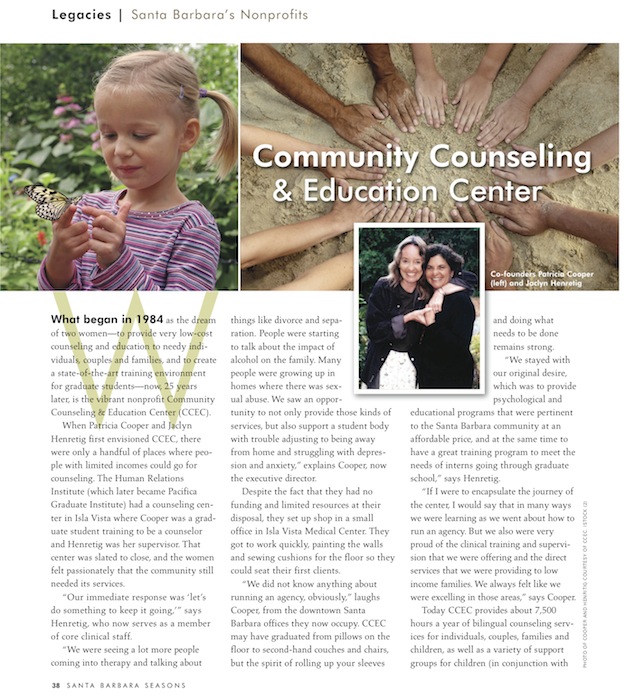
Steven Lovelace (Michelle J. Wong / Noozhawk photo)
As the owner/director of Santa Barbara Dance Arts (with partner Alana
Tillim), Steven Lovelace has his dance card full guiding the jazz hands and pirouettes of more than 400 young students. Here, he takes a brief intermission to talk to Noozhawk.
Leslie Dinaberg: So Arts Alive! which shared your space, is now gone, sadly. But I hear Santa
Barbara Dance Arts is expanding.
Steven Lovelace: Yes. Now my rent just doubled which is pretty scary. But Alana and I … we’re
a very good mix, she’s definitely a great artist and does wonderful choreography
and really good with the kids. She’s a great teacher … I know that it will be good
for us in the long run …
LD: I know a lot of kids that take classes from you and just love it.
SL: They do. We have 400 kids here. Are they going to do it as a profession? I’ve
got a few kids that could be able to do it. Are they talented enough, absolutely,
but you know it also takes intelligence and hard work. …
Some of it here at my studio is social. I know the girls enjoy dancing, I know they
enjoy what I do in the class, but they also enjoy coming in and being a part of this
group … they interface and they interact and it feels good.
LD: I also think you can’t discount just the physical part of dancing. I think as a
parent you realize that your kids need to run around and burn off energy and they
can’t learn if they don’t do that.
SL: And they don’t learn this in school. This doesn’t happen in school. The level
of dancing or the level of vocal coaching that goes on here of the acting classes,
that is not the same, … Before I started this I have worked in practically every
darn school in the city doing independent things.
LD: Will there be changes at your studio now that you have the entire
space?
SL: Now we’re going to really transform this into a performing arts center. …
We’ve got Kindermusik here that’s very successful. … We’ve still got a gallery
space down there. The performing arts need the visual arts anyway because
somebody’s got to build the set to put on the show. I’m about to do two musicals
in the summertime, so this is all individual artists, costumers are individual artists,
they’re not performing artists, so I work with set designers, costumers.
LD: With this transition, is the name of the whole place going to be Santa
Barbara Dance Arts?
SL: Yes. Arts Alive! doesn’t belong to me. … The Arts Mentorship Program is the
nonprofit part of it. That is our scholarship program and our dance companies,
our performing groups, and a lot of internship stuff. We do everything from teach
them to teach classes, we mentor them to choreograph. They are producing their
own things. … The kids right now they are producing their own student
choreography showcase that will be April 26th at 3 p.m. The senior dance
company produces it under our direction, they put the program together, and they
do auditions and do the ticket sales. They do everything.
LD: That’s great. That’s really good experience.
SL: Yes, it’s great. It’s for 14-18 year old kids. They put their own recordings
together, they edit the music for the kids, they do all that. They outreach to the
kids at the dance school. … They can’t walk out of here just being dancers. It
takes more than that to make it in the dance world and we know that, so I’m
teaching kids to teach. You know one girl, she went out of here, she didn’t want
to be a dance major but she taught dance on the side because she could make
20 bucks an hour teaching dance instead of slinging hash and trying to scrape
tips together so that she could help support herself in school. So that’s a really
nice little skill to walk out of here with.
I’ve got one girl in her senior year in high school she choreographed two
musicals in the school. It pays a couple of grand for her to go in and choreograph
eight dances for a musical. She’s so good at it. So she’s working on
choreography and making some money. I’m hiring her this summer to help me
choreograph my musicals because I can’t do everything. She works here in the
summertime; she’s great with teaching. She’s 19.
LD: How long have you been dancing?
SL: I started when I was 21. I actually was doing aerobics up at Nautilus, and the
gal that was running it there who is now one of my moms.
LD: Cindy Elster?
SL: Yes … she pegged me right away in class. I was very coordinated. … I would
be right up in there in the front just going for it, and I moved really well and she
said, “you know, I think you should become a teacher. You should teach. Half the
class is following you anyway.”
So she started having me come up with her on the thing and do the routines with
her and she was really basically training me to teach. (Then she said) “Why
don’t you go up to City College and take a couple of jazz classes? You’ll get all
that.”
So I went to City College and took Kay Fulton’s jazz class. It was actually an
intermediate class and … at the end of the class she lined up half a dozen of us
and she said, “You need to take ballet, you need to take ballet or modern,” she
got up to me and she says, “you can stay.” So I got to stay in the class. And that
was the beginning of dance for me.
LD: That’s kind of wild, it’s late in life, most people start dancing so
young.
SL: It is late, but it’s more common for men. Men can start late. … They get an
accelerated training. I was up in a community college. I wasn’t in a dance studio
hidden away, I was up in a community college where everybody could see me so
within six months somebody from UCSB saw me and called Alice Contadina who
was the department head at the time and she sent one of the teachers out to a
class to observe me and she said “why don’t you come out here and take some
lessons free of charge?” So I went out to UCSB and I danced out there for a year
and then they offered me a spot in their company. By that time I had quit my day
job and had gotten a job at Julie McLeod’s Dance Warehouse. So that’s my
whole history around here. Julie taught me how to teach.
LD: What’s it like to work with all those little girls?
SL: Well, there’s a lot of different ways I could answer that. … I think it’s really
important to be a place where girls can be empowered, which is one of the big
reasons we want to mentor girls and give them social skills because every time
they don’t make that audition it’s a skill to know how to take that rejection of not
getting what they want. The first time you don’t get into the college that you want,
if you don’t get that job that you think you’re perfect for that they give to someone
else.
… We really, really feel strongly that we’re providing a service, not just in giving
excellence in dance training or contemporary dances but we’re giving your kids a
community that they can feel good about. And the kids love being here.
… And I know that some of that is because it’s a great experience for them to be
here, but I have to say we provide this forum where they can be seen at
whatever talent level they are at or whatever their interest in dance is. Whether
they are just here for an after school class or they have an aspiration to go on
and go to Broadway and be in music videos or be a director or whatever. It’s here
for them and we want to be there. We take them all seriously. We don’t talk down
to the kids here. We really believe in that.
LD: If you could pick three adjectives to describe yourself, what would they
be?
SL: Holistic, resourceful, appreciative
Vital Stats: Steven Lovelace
Born: Santa Barbara, on June 6, 1957
Family: Partner Gary Clark
Civic Involvement: Santa Barbara’s Summer Solstice, Lit Moon Theatre
Company; Santa Barbara Dance Alliance: Arts Mentorship Program; Fund for
Santa Barbara
Professional Accomplishments: Co-owner/director Santa Barbara Dance Arts;
Co-owner/director Stage Left Productions; Teacher at Arts at Laguna; Former
Artistic Director and Artist in Residence with Santa Barbara’s Summer Solstice;
Dancer with Repertory-West Dance Company, Santa Barbara Dance Theatre,
Santa Barbara Civic Light Opera, Bill Evans Dance Company, and Nora
Reynolds Dance.
Best Book You’ve Read Recently: (laughs) “Twilight. It’s not like they are the
best-written books in the world but there’s something very engaging about those
characters.”
Little-Known Fact: “I like to be alone.”
Originally published in Noozhawk on April 12, 2009. Click here to read the story on that site.
 We have so many choices, yet so few of them are really important.
We have so many choices, yet so few of them are really important.

 Celebrating 25 Years of Service
Celebrating 25 Years of Service By
By 
